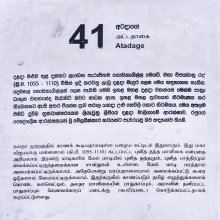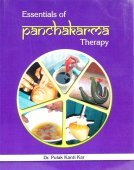Madi, Mādi, Māḍi: 14 definitions
Introduction:
Madi means something in Hinduism, Sanskrit, Marathi, biology. If you want to know the exact meaning, history, etymology or English translation of this term then check out the descriptions on this page. Add your comment or reference to a book if you want to contribute to this summary article.
Images (photo gallery)
In Hinduism
Purana and Itihasa (epic history)
Source: Cologne Digital Sanskrit Dictionaries: The Purana IndexMādi (मादि).—A sage.*
- * Matsya-purāṇa 196. 26.

The Purana (पुराण, purāṇas) refers to Sanskrit literature preserving ancient India’s vast cultural history, including historical legends, religious ceremonies, various arts and sciences. The eighteen mahapuranas total over 400,000 shlokas (metrical couplets) and date to at least several centuries BCE.
Biology (plants and animals)
Source: Wisdom Library: Local Names of Plants and DrugsMadi [ಮಾದಿ] in the Kannada language is the name of a plant identified with Boswellia serrata Roxb. ex Colebr. from the Burseraceae (Torchwood) family having the following synonyms: Boswellia glabra, Boswellia thurifera, Bursera thurifera. For the possible medicinal usage of madi, you can check this page for potential sources and references, although be aware that any some or none of the side-effects may not be mentioned here, wether they be harmful or beneficial to health.
Source: Google Books: CRC World Dictionary (Regional names)1) Madi in India is the name of a plant defined with Areca catechu in various botanical sources. This page contains potential references in Ayurveda, modern medicine, and other folk traditions or local practices It has the synonym Areca faufel Gaertn. (among others).
2) Madi is also identified with Boswellia serrata It has the synonym Boswellia glabra Roxb. ex Colebr. (etc.).
Example references for further research on medicinal uses or toxicity (see latin names for full list):
· Pl. Coromandel (1811)
· Planta Medica (1998)
· Planta Medica (2001)
· Asiatic Researches, or ‘Transactions of the Society’ (1807)
· Species Plantarum
· Flora Indica, or ‘Descriptions of Indian Plants’ (1768)
If you are looking for specific details regarding Madi, for example pregnancy safety, side effects, chemical composition, extract dosage, diet and recipes, health benefits, have a look at these references.

This sections includes definitions from the five kingdoms of living things: Animals, Plants, Fungi, Protists and Monera. It will include both the official binomial nomenclature (scientific names usually in Latin) as well as regional spellings and variants.
Languages of India and abroad
Marathi-English dictionary
Source: DDSA: The Molesworth Marathi and English Dictionarymāḍī (माडी).—f (māḍa) The exudation obtained from the Cocoanut-tree; as tāḍī is that from the tāḍa (Fanleaved Palm); although to both indiscriminately we apply the term toddy. 2 An upper story (esp. that of a house having but one). Ex. māḍyā gōpurēṃ kavalārēṃ || ēkasarēṃ bhaḍakāvalīṃ ||. 3 A loft. māḍī is planked or boarded, and thus differs from māḷā or māḷa. 4 A common term for the long roots of aḷūṃ (Calladium): the short and roundish are called muḍaḷī.
--- OR ---
mādī (मादी).—f ( P) The female: as opp. to nara The male. 2 That member of a hinge which receives the spike &c. See naramādī. 3 A common term for the side-screwbeams, or if but two, the name of the smaller.
Source: DDSA: The Aryabhusan school dictionary, Marathi-Englishmāḍī (माडी).—f The exudation obtained from māḍa. An upper story. A loft. māḍīvara Upstairs.
--- OR ---
mādī (मादी).—f The female. That member of a hinge which receives the spike.
Marathi is an Indo-European language having over 70 million native speakers people in (predominantly) Maharashtra India. Marathi, like many other Indo-Aryan languages, evolved from early forms of Prakrit, which itself is a subset of Sanskrit, one of the most ancient languages of the world.
Sanskrit dictionary
Source: DDSA: The practical Sanskrit-English dictionaryMadi (मदि).—f. A kind of roller or harrow.
Derivable forms: madiḥ (मदिः).
--- OR ---
Māḍi (माडि).—A palace.
Derivable forms: māḍiḥ (माडिः).
Source: Cologne Digital Sanskrit Dictionaries: Shabda-Sagara Sanskrit-English DictionaryMadi (मदि).—f.
(-diḥ) A kind of harrow. E. mṛda-in pṛṣo0 .
--- OR ---
Māḍi (माडि).—m.
(-ḍiḥ) A palace.
Source: Cologne Digital Sanskrit Dictionaries: Cappeller Sanskrit-English DictionaryMadi (मदि).—[feminine] a kind of harrow or roller.
Source: Cologne Digital Sanskrit Dictionaries: Monier-Williams Sanskrit-English Dictionary1) Madī (मदी):—[from mada > mad] f. any agricultural implement (as a plough etc.), [cf. Lexicographers, esp. such as amarasiṃha, halāyudha, hemacandra, etc.]
2) Madi (मदि):—or madikā f. a kind of harrow or roller, [Kṛṣisaṃgraha] (cf. matya).
3) Māḍi (माडि):—m. a palace, [cf. Lexicographers, esp. such as amarasiṃha, halāyudha, hemacandra, etc.]
Source: Cologne Digital Sanskrit Dictionaries: Yates Sanskrit-English DictionaryMāḍi (माडि):—(ḍiḥ) 2. m. A palace.
[Sanskrit to German]
Sanskrit, also spelled संस्कृतम् (saṃskṛtam), is an ancient language of India commonly seen as the grandmother of the Indo-European language family (even English!). Closely allied with Prakrit and Pali, Sanskrit is more exhaustive in both grammar and terms and has the most extensive collection of literature in the world, greatly surpassing its sister-languages Greek and Latin.
Kannada-English dictionary
Source: Alar: Kannada-English corpusMaḍi (ಮಡಿ):—
1) [verb] to bend (cloth, paper, etc.) over upon itself; to fold.
2) [verb] to pull off or out (as a flower from a plant); to pluck.
3) [verb] to force to bend or to become curved; to bend.
4) [verb] to be suspended; to be hung.
5) [verb] to become lower in level; to sink in.
6) [verb] to bend oneself; to be bent or become crooked.
7) [verb] (the tongue) to become dry and inactive (from bewilderment, fear, etc.).
8) [verb] to shut oneself; to undergo shutting.
9) [verb] to pass from physical life and lose all bodily attributes and functions necessary to sustain life; to die.
10) [verb] to come to an end; to be over.
--- OR ---
Maḍi (ಮಡಿ):—[adjective] expressing order or succession, esp. of a number in a series; ordinal.
--- OR ---
Maḍi (ಮಡಿ):—
1) [noun] the act of folding.
2) [noun] a folded part or layer; a fold.
3) [noun] any one of a series of moments at which the same or nearly the same thing recurs; repeated occasion.
4) [noun] the quality or condition of being pure; purity.
5) [noun] washed clothes.
6) [noun] a silk cloth considered to be ever religiously clean.
7) [noun] a keeping from being religiously defiled.
8) [noun] a basin for holding water around a plant.
9) [noun] a piece of land ridged all around and prepared for sowing, transplantation, etc.
10) [noun] ಮಡಿ ನೀರು [madi niru] maḍi nīru religiously undefiled water; water kept for religious purpose; 2. the bathing of a woman on the fourth day of discharging of menses; ಮಡಿಯಾಗು [madiyagu] maḍiyāgu to become clean, esp. religiously; 2. (a widow) to get the hair shaved off from her head; ಮಡಿಯುಟ್ಟುಕೊಳ್ಳು [madiyuttukollu] maḍiyuṭṭukoḷḷu to wear clearn, washed clothes; ಮಡಿಹಿಡಿ [madihidi] maḍi hiḍi = ಮಡಿಯಾಗು - [madiyagu -] 2; 2. to get branded with a hot metal; ಮಡಿ ಹೆಂಗಸು [madi hemgasu] maḍi hengasu a brāhmaṇa widow who has got her head shaven.
--- OR ---
Maḍi (ಮಡಿ):—[noun] = ಮಡ [mada]1.
--- OR ---
Māḍi (ಮಾಡಿ):—[noun] = ಮಾಡ [mada]1.
--- OR ---
Māḍi (ಮಾಡಿ):—[noun] a carriage, vehicle.
--- OR ---
Māḍi (ಮಾಡಿ):—[noun] the sap of cocoanut palm that is used in preparing alcoholic liquor.
--- OR ---
Mādi (ಮಾದಿ):—
1) [noun] the middle-sized, deciduous tree Boswellia serrata ( = B. thurifera) of Burseraceae family; Indian olibanum tree.
2) [noun] its fruit.
Kannada is a Dravidian language (as opposed to the Indo-European language family) mainly spoken in the southwestern region of India.
Nepali dictionary
Source: unoes: Nepali-English Dictionary1) Māḍī (माडी):—n. 1. big flat land; 2. pilgrimage site; fair;
2) Mādī (मादी):—n. 1. name of a river in Nepal; Madi river; 2. name of a place in Sankhuwasabha district; Madi;
Nepali is the primary language of the Nepalese people counting almost 20 million native speakers. The country of Nepal is situated in the Himalaya mountain range to the north of India.
See also (Relevant definitions)
Starts with (+232): Madavamtike, Madi haale, Madi-alum, Madia, Madia-nhoka, Madialum, Madiata ngombe, Madiawa, Madicu, Madiel, Madiga, Madigadde, Madigavare, Madigavarike, Madige, Madigimta, Madigiriya, Madigitti, Madigolisu, Madigolu.
Ends with (+219): A-campirannatacamati, Acammati, Adavi-gummadi, Adavigummadi, Adavimamadi, Adhyatmadi, Ahammadi, Aimadi, Amaimati, Amati, Anamtamadi, Angaradhumadi, Ankaramati, Anticamati, Anumati, Armati, Arotamati, Arumadi, Ashmadi, Atimati.
Full-text (+65): Mandura, Brahmadrijata, Mad, Mandana, Indupramati, Muphopha-madi, Pankamanduka, Vimadikri, Madi haale, Matuvan, Mandayamana, Amalibaba, Maticevi, Bhumimanda, Mativitu, Madika, Viddhaka, Matsa, Matippanam, Mandata.
Relevant text
Search found 9 books and stories containing Madi, Mādi, Māḍī, Mādī, Māḍi, Madī, Maḍi; (plurals include: Madis, Mādis, Māḍīs, Mādīs, Māḍis, Madīs, Maḍis). You can also click to the full overview containing English textual excerpts. Below are direct links for the most relevant articles:
Garga Samhita (English) (by Danavir Goswami)
Verse 1.6.10 < [Chapter 6 - Description of Kaṃsa’s Strength]
Amarakoshodghatana of Kshirasvamin (study) (by A. Yamuna Devi)
Cāndra system of grammar < [Chapter 6 - Grammatical Aspects]
Kashyapa Shilpa-shastra (study) (by K. Vidyuta)
1. Definition of Maṇḍapa (pavilions) < [Chapter 4 - Maṇḍapa Lakṣaṇa]
Historical Elements in the Matsya Purana (by Chaitali Kadia)
Lineages of Aṅgirā < [Chapter 6 - Human history in the Matsya-Purāṇa]
Rig Veda (translation and commentary) (by H. H. Wilson)
Rig Veda 9.107.12 < [Sukta 107]
Folk Tales of Gujarat (and Jhaverchand Meghani) (by Vandana P. Soni)
Chapter 18 - Gana Gor < [Part 3 - Kankavati]
Chapter 37 - Bapu Bhalalo < [Part 5 - Rang Chee Barot]
Related products



